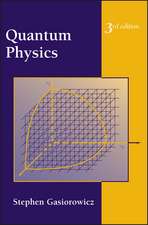Nonlocality in Quantum Physics
Autor Andrey Anatoljevich Grib, Waldyr Alves Rodrigues Jr.en Limba Engleză Hardback – 31 iul 1999
| Toate formatele și edițiile | Preț | Express |
|---|---|---|
| Paperback (1) | 640.55 lei 43-57 zile | |
| Springer Us – 17 oct 2012 | 640.55 lei 43-57 zile | |
| Hardback (1) | 644.30 lei 43-57 zile | |
| Springer Us – 31 iul 1999 | 644.30 lei 43-57 zile |
Preț: 644.30 lei
Preț vechi: 758.01 lei
-15% Nou
Puncte Express: 966
Preț estimativ în valută:
123.29€ • 129.05$ • 102.61£
123.29€ • 129.05$ • 102.61£
Carte tipărită la comandă
Livrare economică 31 martie-14 aprilie
Preluare comenzi: 021 569.72.76
Specificații
ISBN-13: 9780306461828
ISBN-10: 030646182X
Pagini: 225
Ilustrații: X, 225 p.
Dimensiuni: 178 x 254 x 17 mm
Greutate: 0.53 kg
Ediția:1999
Editura: Springer Us
Colecția Springer
Locul publicării:New York, NY, United States
ISBN-10: 030646182X
Pagini: 225
Ilustrații: X, 225 p.
Dimensiuni: 178 x 254 x 17 mm
Greutate: 0.53 kg
Ediția:1999
Editura: Springer Us
Colecția Springer
Locul publicării:New York, NY, United States
Public țintă
ResearchCuprins
1. Introduction.- References.- 2. Fundamentals.- 2.1 The rules of the game.- 2.2 The whole and its parts.- 2.3 Classical limit and decoherence.- 2.4 Proofs of the frequency interpretation.- References.- 3. How ? Collapses.- 3.1 The problem.- 3.2 Collapse and unitary evolution.- References.- 4. Bell’s Inequalities.- 4.1 The Einstein, Podolski and Rosen (EPR) argument.- 4.2 D’Espagnat’s version of Bell’s inequalities.- 4.3 Stapp’s formulation of Bell’s inequalities.- 4.4 Bell’s proof.- References.- 5. Copenhagen Interpretation.- 5.1 Absence of quantum objects.- 5.2 Objectively existing potentialities world.- References.- 6. Many Worlds Interpretation (MWI).- 6.1 The role of the observer.- 6.2 Nonlocality.- 6.3 Criticisms.- References.- 7. Quantum Logic (QL).- 7.1 Proposal.- 7.2 Hasse diagrams.- 7.3 The birth of time.- References.- 8. Macroscopic Realizations of QL.- 8.1 Lattices and graphs.- 8.2 Breakdown of Bell’s inequalities.- 8.3 The Problem of Nonlocality.- References.- 9. Hidden Variables Theories (HVT).- 9.1 What is a hidden variables theory?.- 9.2 Von Neumann’s theorem.- 9.3 Spin 1/2 hidden variable’s model.- 9.4 Gleason’s theorem. Kochen-Specker paradox.- References.- 10. De broglie-Bohm Non. Relativistic HVT.- 10.1 Non relativistic de Broglie-Bohm theory.- 10.2 The many particle system.- 10.3 Remarks on the non relativistic BBT.- References.- 11. De Broglie-Bohm Relativistic HVT.- 11.1 HVT interpretation of the boson equations.- 11.2 The BBT interpretation of the Dirac equation.- 11.3 Relativistic BBT many-fermion theory.- 11.4 Necessity of superluminal processes.- References.- 12. Statistical Interpretation.- 12.1 Introduction.- 12.2 When is the SIQT possible?.- 12.3 SIQT × orthodox quantum theory.- References.- 13. Non-UnitaryEvolution?.- 13.1 Prigogine and Ghirardi et al. theories.- 13.2 Criticisms.- References.- 14. Histories Approach.- 14.1 What is a history?.- 14.2 Consistent histories.- 14.3 Criticisms.- References.- 15. Quantum Miracles and Cryptography.- 15.1 Greenberger et al. example.- 15.2 Hardy’s example.- 15.3 Negative experiments. Elitzur-Vaidman proposal.- 15.4 Delayed choice experiments.- 15.5 Quantum erasers.- 15.6 Quantum cryptography.- 15.7 Teleportation.- References.- 16. Where are We Now?.- References.- Appendices.- A— Set Theory and Lattices.- A.1 Main definitions.- A.2 Posets.- A.3 Lattices.- A.4 The Boolean algebra of sets.- A.5 Borel sets, measures and integration.- References.- B— Hilbert Spaces.- B.1 Definition of Hilbert Space.- B.2 Linear manifolds and subspaces.- B.2.1 The lattice of subspaces.- B.3 Dual and conjugate dual spaces.- B.4 Tensor products.- B.5 Linear operators.- B.6 Projection operators and lattice structure.- References.













